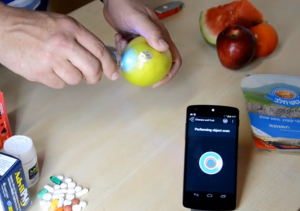
Image: Consumer Physics
What if, when you looked at a piece of cheese (for example), you saw not only the cheese’s shape, color, texture, and the like, but also its chemical composition? Thanks to portable near-infrared spectroscopes now under development, you may soon be able to scan cheese or virtually any other object to learn facts about its chemical makeup.
Jon Phillips of PCWorld recently tried out a prototype of the SCiO spectrometer, reporting:
I scanned a hunk of gouda, and the accompanying app reported the cheese’s specific fat, carb, protein and calorie content for a single serving. Comparing SCiO’s numbers to the cheesemaker’s published nutritional information, the sensor was within 10 percent of each advertised metric.
Not only did the SCiO detect that a pill under inspection contained the drug Ibubrofen, Phillips reports, the device (along with its accompanying cloud software) distinguished between generic and name-brand pills containing the drug.
The potential applications are practically limitless. With such a device, soon you may be able to easily learn significant details about the chemical makeup of everything you put on or into your body—and of your body itself.
Although the developers of SCiO emphasize it is “not a medical device,” one can easily imagine the portable technology developed to analyze blood samples, urine samples, and the like—whether in the lunchroom at your office or on a mountain peak.
Mechanics could use such a device to test auto fluids, brewers could use it to check the ingredients of their beer, farmers could use it to test their soil, and so on. This is potentially revolutionary technology.
And then there are the implications in the field of education. School children everywhere could employ affordable, portable spectroscopy to explore the world around them.
So how does the device work? Consumer Physics, the device’s developer, explains:
SCiO includes a light source that illuminates the sample and an optical sensor called a spectrometer that collects the light reflected from the sample. The spectrometer breaks down the light to its spectrum, which includes all the information required to detect the result of this interaction between the illuminated light and the molecules in the sample.
Spectrometers used for near-IR spectroscopy are normally found in scientific laboratories and are very big and expensive. Designed for consumers, SCiO leverages a tiny spectrometer, designed from the ground up to be mass-produced at low cost. Consumer Physics achieved this advancement by reinventing the spectrometer around low-cost optics and advanced signal processing algorithms.
To deliver relevant information in real time, SCiO communicates the spectrum of the sample to a smartphone via Bluetooth, which in turn forwards it to a cloud-based service for review. Advanced algorithms utilize an updatable database to analyze the spectrum within milliseconds and deliver information about the analyzed sample back to the user’s smartphone in real time.
Whether Consumer Physics will successfully develop its product for a mass market is yet to be seen. (Tellspec is developing a competing product.) But the results of prototypes look promising, and the company has raised over $370,000 in a Kickstarter campaign to help finance development.
Whether SCiO or some other company ultimately delivers a product to consumer, it seems likely that we will soon live in an era in which portable spectroscopy is commonplace. Yet again the men of the mind find an innovative way to advance human life.
https://www.youtube.com/watch?v=sSiturTkrLw
https://www.youtube.com/watch?v=ZxNeFYIRt94
Related:
- FrackNation Defends Revolutionary Energy Technology
- Celebrating Dolly’s Birthday: Advancements in Cloning Technology













